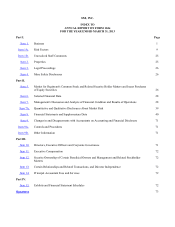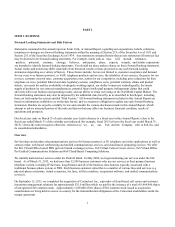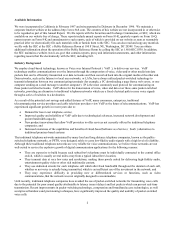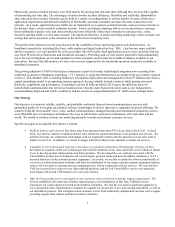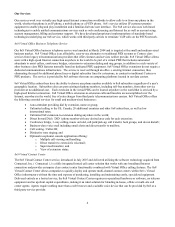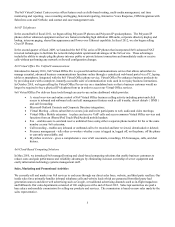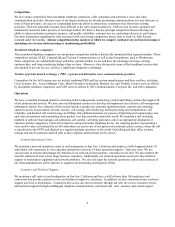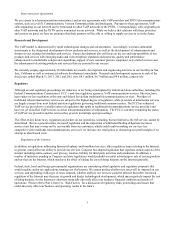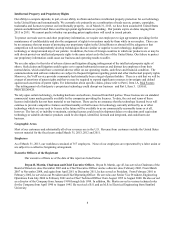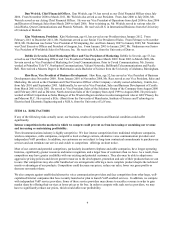8x8 2013 Annual Report Download - page 12
Download and view the complete annual report
Please find page 12 of the 2013 8x8 annual report below. You can navigate through the pages in the report by either clicking on the pages listed below, or by using the keyword search tool below to find specific information within the annual report.10
We also are subject to the risk that new technologies may be developed that are able to deliver competing voice services at
lower prices, better or more conveniently. Future competition from new technologies could have a material adverse effect on
our growth and operating results.
Given the significant price competition in the markets for our products, we are at a significant disadvantage compared to many
of our competitors, especially those with substantially greater resources, and therefore may be better able to withstand an
extended period of downward pricing pressure. The adverse impact of a shortfall in our revenues may be magnified by our
inability to adjust spending to compensate for such shortfall. Announcements of new products and technologies by our
competitors or us could cause customers to defer purchases of our existing products, which also could have a material adverse
effect on our business, financial condition or operating results.
The success of our Company is dependent on the growth and public acceptance of our services.
Our future success depends on our ability to significantly increase revenues generated from our services. In turn, the success of
our voice and video communications services depends, among other things, upon future demand for VoIP telephony systems
and services. Because the use of our service requires that the user be a subscriber of an existing broadband Internet service,
usually provided through a cable or digital subscriber line, or DSL, connection, slow or limited adoption of broadband Internet
service could adversely affect the growth of our subscriber base and revenues. Although the number of broadband subscribers
worldwide has grown significantly over the last five years, VoIP service has not yet been adopted by a majority of prospective
business customers. According to a report filed by the FCC in January 2013, as of December 31, 2011, approximately 9.5% of
access lines to businesses in the United States utilize interconnected VoIP services. To increase the deployment of broadband
Internet services from broadband Internet service providers, telephone companies and cable companies must continue to invest
in the deployment of high speed broadband networks to residential and business customers, over which we have no control. In
addition, VoIP networks must improve quality of service for real-time communications, managing effects such as packet jitter,
packet loss, and unreliable bandwidth, so that toll-quality service can be consistently provided. VoIP telephony equipment and
services must achieve a similar level of reliability that users of the PSTN have come to expect from their telephone service, and
the cost and feature benefits of VoIP must be sufficient to cause customers to switch away from traditional telephony service
providers. We must devote substantial resources to educate customers and end users about the benefits of VoIP telephony
solutions, in general, and our services in particular. Substantial, ongoing interaction with our customers in order to train and
assist them with the deployment and use of our services over these networks is sometimes required. If any or all of these
factors fail to occur, our business may be affected adversely.
The impact of the current economic climate and adverse credit markets may impact customer demand for our products
and services.
Many of our existing and target customers are in the small and medium business sector. Although we believe our products and
services are less costly than traditional telephone services, these businesses may be more likely to be significantly affected by
economic downturns than larger, more established businesses. They also may be more likely to require working capital
financing from local and regional banks whose lending activities have been reduced substantially since 2008, as a result of
which the existing and target customers may lack the funds necessary to add new equipment and services such as ours.
Additionally, these customers often have limited discretionary funds which they may choose to spend on items other than our
products and services. If small and medium businesses continue to experience economic hardship, this could negatively affect
the overall demand for our products and services, delay and lengthen sales cycles and lead to slower growth or even a decline
in our revenue, net income and cash flows.
Although the majority of our billing arrangements with customers are prepaid, we regularly monitor the percentage of
customers who cease to pay for our services due to closing or downsizing their business. In general, our customers may
terminate their subscriptions for our services on 30 days notice. Even though our customer churn rates improved in fiscal 2013,
we believe that more than 50% of our total customer churn is related to customers’ financial condition and cannot be certain
that we will continue to experience the same improvement in churn rates given current economic conditions. Additionally, the
combination of our sales cycle coupled with challenging economic conditions could have a negative impact on the results of
our operations.


